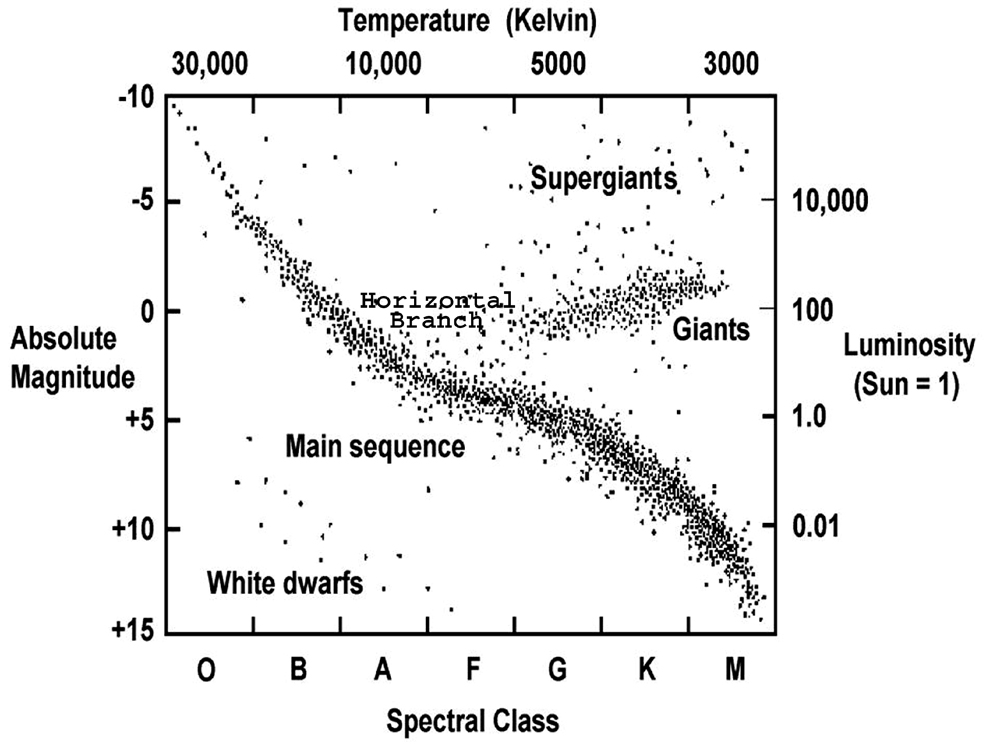- THE SUN, a typical star:
The Sun is the largest and most massive object in the Solar System, containing about 99.8% of all the Solar System's mass.
It is a ball of gas at temperatures measured in millions of degrees. At this temperature, the nuclei of atoms are separate from their electrons.
About 91% of the atoms in the Sun are Hydrogen (H) and 8.9% are Helium (He); all the rest add up to just 0.1%.
The energy of the sun is generated by thermonuclear fusion, comparable to the reactions of a hydrogen bomb.
The overall process can be summarized as:
4 11H ——> 24He + 2 10n + energy
(For further details, click here.)
- Origin and Fate of the Sun:
Scientists think that the Sun formed about 4.5 billion years ago from a giant rotating cloud of dust and gas called the Solar Nebula.
Most of this mass collapsed inward toward the center by gravitational attraction, spinning faster and faster to form a disc.
About 99.8% of the matter in the Solar Nebula collapsed in the center and formed the Sun.
The remaining 0.2% formed all the planets, satellites, and other material.
As the mass of the Sun's center increased, its temperature rose to the point that thermonuclear fusion began, which heated up the interior even more.
The Sun will continue to burn fuse hydrogen atoms into helium until it runs out of hydrogen atoms, approximately 6.5 billion years into the future.
Once the Sun runs out of fuel, scientists think that it will expand to form a red giant for about 1 billion years,
then shrink in size and become a white dwarf and eventually a dead star or "black dwarf".
- Comparison with other stars:
Stars are classified by their brightness (luminosity) and by the principal wavelength of the light that they emit.
The Sun is a fairly typical star that emits mostly yellow light.
- The H-R diagram:
Scientists can plot different stars on a diagram that shows their luminosity and principal wavelength.
This diagram is called the Hertzsprung-Russell diagram or H-R diagram.
The horizontal axis of this diagram (going from right to left!) shows the principal
color of the energy emitted by the star, which is
a function of its Temperature.
The coolest stars (on the right) emit mainly red light; the orgnge, yellow, and white stars are
in the middle, and the hottest stars (on the left) emit mostly blue light.
The vertical axis is a measure of Luminosity, the total rate at which radiant energy is emitted, on a logarithmic scale
in thich our Sun is given a value of 1.0
A Luminosity of 100 therefore means "100 times as bright as the Sun."
(What we usually call "brightness" is properly called "apparent brightness", which depends
on luminosity but also on distance.
If you shine a flashlight into your eyes it appears many times brighter than any star in the sky because it is much closer.)
- The "Main Sequence":
Most of the stars on the Hertzsprung-Russell diagram fall into a large band called the Main Sequence.
Our Sun is a fairly typical, middle-size star in the middle of this Main Sequence, emitting mostly Yellow light.
Astronomers think that stars spend most of their lives, several billions of years, along this Main Sequence.
Stars further to the right on this Main Sequence are less luminous and cooler. They may be smaller, but not always.
Stars further to the left on the Main Sequence are more luminous and hotter. They are often larger as well.

(Another version of this diagram is on page 15 of
this reference chart)
Red Giants and White Dwarfs
A few unusual stars fall outside the Main Sequence:
Red Giants are very large stars that emit mostly red light. They are very old or dying stars.
White Dwarfs are very small, dense stars that emit mostly white light. They are thought to be very, very old or dead.
Black Dwarfs are even smaller "dead" stars that emit almost no light at all.
- Infant Stars ("Proto-Stars"):
Young stars, in their early stages of formation, are called Infant Stars or Proto-Stars.
According to
this article, Proto-stars and their planets form together at about the same time as they condense from a star-forming nebula.
- Constellations:
A Constellation is an arbitrarily observed grouping of stars that appear in the same region of the sky from our vantage point.
The stars in a constellation may not be close to one another at all, because they may be at very different distances away from us in the same direction.
The names of constellations are usually derived from Greek and Roman mythology.
- Exoplanets:
A planet circling a star outside our Solar System is called an exoplanet.
The best way to detect an exoplanet is when its orbit causes it to pass between its own star and our Solar System.
When that "occlusion" happens, the light from the star dims just a bit because is it partially blocked by the planet.
We can measure how often the occlusion happens and how much dimming occurs; this allows us to estimate
the size of the planet and some features of its orbit.
To date, a few thousand exoplanets have been detected, and scientists think these are just a small fraction of the many more that exist.
Only the largest exoplanets can be detected by this method, and only if their orbits bring them into occlusion with our line of sight.
|